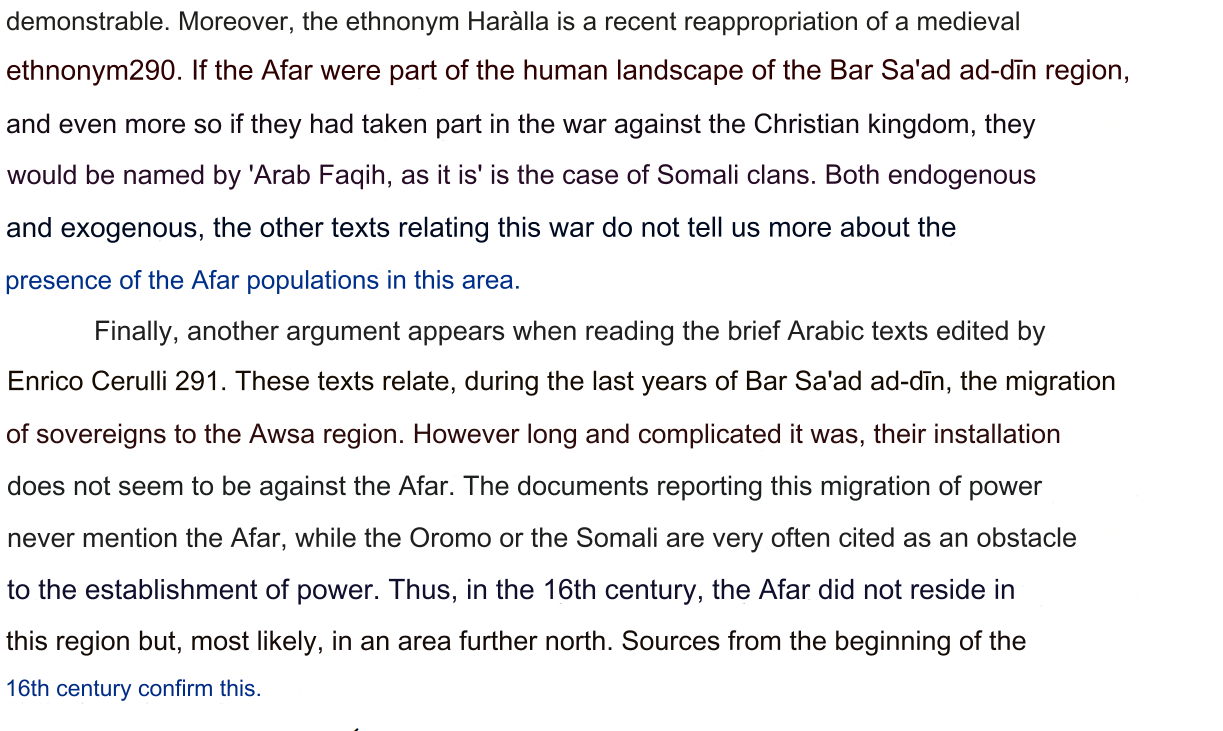"At Badwein, in the centre of that part of the Nogal Valley which is occupied by the Arasama sub-tribe, we discovered extensive ruins of an ancient city, and close by a large tank quarried out of the gypsum rock. The deserted ruins covered an area of about 40,000 square yards, choked up with cactus and aloes, the haunt of leopards and hyasnas. Most of the houses have been reduced to mounds of stone and rubble, covered with straggling mimosa bushes, but here and there the walls of houses were better preserved. We rode into one house, whose walls stood some 10 feet high, and found it divided into many partitions, the building being in the form of a parallelogram, with sides 200 feet long and 100 feet wide. Curious niches hero and there would seem to have been used as fire-places.
The Somalis said this civilised people cultivated all the lands around, and occupied large cities, that they could read and write, and that when their (the Somalis') fathers came to the country, many buildings bore traces of writing which had long since been worn away by the work of time. They called the people " Harli,"
The latter had dug the rocky wells at Kirrid which we saw on first entering the country, and had cut a rude Christian cross in the face of the cave—■ the only ancient sign existing of a rude form of Christianity in the land. We tried to decipher what was said to be writing on the pillar of a doorway ; but it waB impossible to make out any lotters, as the surface of the gypsum stones, of which all the houses were built, had become much decomposed by the action of rain, and looked spongy, like pumice-stone. We rode with our party of Dulbahantas in amongst the ruins, out of one house into another, and, standing on high heaps of debris, let our eyes range over a landscape dotted with crumbling grey walls imbedded in clumps of aloes and cactus. As we picked our way among the fallenblocks, we disturbed a herd of deer feeding inside the remains of an old building, and everywhere guinea-fowl, of the species called vulturine, scuttled out of our path. We wished much to dig amongst the ruins for ancient pottery, etc., but wero prevented from doing so by the suspicion and prejudice of our hosts, who consider any tampering with these places as sacrilegious. There were many old graves, some of which seemed to be built in the form of a cross; they were plastered over with a mortar composed of pounded gypsum and water. The Dulbahantas now make their graves in the same manner, only Moslem in design; always in the vicinity of water, as certain rites, for which water is necessary, have to be carried out. In some cases dead men are carried, strapped on camels, long distances in order to be buried near water.
We much wished to remain some days and explore tbis dead city, but various sub-tribes of Dulbahantas were very uneasy and suspicious of our intentions, so we thought it advisable not to prolong our stay. They could not understand why we roamed about in desolate places instead of accepting the hospitality of their wandering camps, where the whole place was infested with camel-ticks ; and having seen us working the theodolite, they credited us with designs of presently bringing an army to take the country. They dissuaded us as well as they could from proceeding to tho out-of-the-way peaks we had fixed upon as points of observation, and placed many obstacles in the way, assuring us we should be attacked by savage tribes, and that we were going into a country utterly waterless, that our camels would be devoured by lions, etc. Seeing, however, that we went all the same, and discovered water in spite of them, they gave up the attempt, and we were better friends after."



